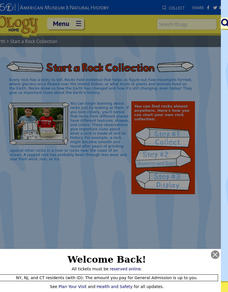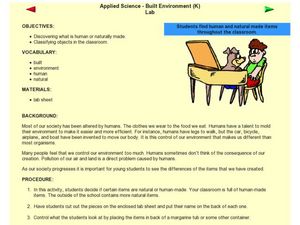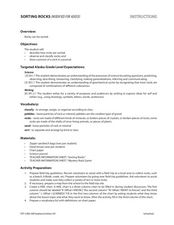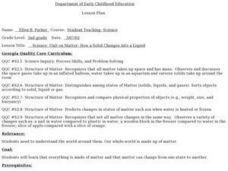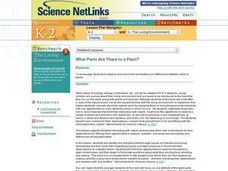Curated OER
Water Works Wonders
Students examine where water is found in the world, how we use it, and the various forms it takes. They observe the refraction of light through a prism, record the day and night sky over a week's time, and create a topographic model of...
Curated OER
Bivalve or Univalve (Clam or Snail)?
Fourth graders explore the meaning of the prefixes "bi" and "uni." In groups, 4th graders observe pictures of shells and handle real shells. Students create a chart to classify each shell as a bivalve or univalve. They identify the...
Columbus City Schools
Sedimentary Rocks
Turn your class discussion of rock formation from ho-hum to holy hornfels! Junior geologists gain experience in identifying rock types and rock origins, with an emphasis in hypothesizing the environment needed to form certain...
American Museum of Natural History
Start a Rock Collection
Rocks hold evidence of Earth's past. A three-step guide describes the process of creating a rock collection. It provides a data collection sheet to make notes about each sample.
Curated OER
Let's Take a Rock Apart
Students take a crushed rock and sort the remains of the rock minerals into different categories based on the different properties. In this sorting lesson plan, students learn what makes up a rock and how to sort something into categories.
Curated OER
Look At Those Leaves!
Students observe, measure and sort leaves. In this leaf lesson students divide into groups and observe the different kinds of leaves.
Curated OER
Organization: Look at What I Organized!
Students explore organization by participating in an object sorting activity. In this indexing lesson plan, students examine their classroom and identify materials that should be organized in order to make the room more efficient....
Curated OER
Solids and Water
Students investigate mixtures made of water and familiar solid materials. They observe and discuss the changes that occur immediately and set the mixtures aside for a day. Finally, students observe the mixtures, note changes, and graph...
Curated OER
Human or Natural?
Students explore nature by participating in a class lab activity. In this human vs. nature lesson plan, students examine a group of items in their classroom and discuss whether they were created naturally or have been altered or created...
Curated OER
The Button Box
Students classify buttons. In this classification instructional activity, students listen to the book The Button Box by Margarette S. Reid before observing, describing and classifying real buttons.
Curated OER
How Can Plants Be Sorted?
In this plant classification worksheet, students will observe a variety of different plants and categorize each plant by its flowers, leaves, and spines. This worksheet had 13 fill in the blank questions.
Curated OER
Name that animal
A great way to classify organisms, is by counting the number of legs it has or how it moves. Little ones count the legs on five different creatures, then match the leg count to the proper animal name. Tip: Have them come up with other...
Curated OER
Sorting Rocks
Students develop a rock word web during a large group discussion. Using the categories generated during that discussion, they sort their rock samples accordingly.
Curated OER
Science: How Solids Become Liquids
Second graders discover how matter changes from one state to another by observing melting ice cubes. They decide on means to warm the ice and predict what will happen. Students record how long it takes for the cubes to melt.
Curated OER
Spreadsheets in Science
Fourth graders create spreadsheets, explore patterns and make predictions based on the information. They select the appropriate graph to display the spreadsheet data. They search and sort prepared data bases to gain knowledge for...
Curated OER
Science: A Tree for All Seasons
Students observe trees in their schoolyard and record the seasonal changes by drawing pictures. In this ongoing lesson, they discover the names of the seasons and place green paper leaves on a paper tree in the classroom, which are also...
Curated OER
Science: Liquid Matter
Second graders examine the properties of liquids and their classifications. They compare and contrast cups of different liquids and record their findings in journals. Students observe how liquids flow at various speeds and that unlike...
Curated OER
Rock vs. Mineral - Lesson #1
Students describe visual, textural, and other physical qualities of sample rock specimens. Using compare and contrast skills, students sort and classify the specimens according to their assessments of the qualities present in each....
Curated OER
Classifying Candy I
Students explore the observable properties of matter. They develop two binary classification systems using concrete objects. based on two different properties of the concrete objects.
Curated OER
What Parts Are There to a Plant?
Young scholars identify and sort plant parts through hands-on activities and group discussions and then work with magnifying lenses and tape measures to document their observations on a student sheet.
Curated OER
Look At Those Leaves!
Students observe and sort tree leaves. In this earth science lesson, students observe the attributes of real leaves and measure leaves using Unifix cubes.
Curated OER
Cell Discoveries
Students observe, compare and describe cell organelles in terms of their function, structure and operation. They enter and edit information in a database, build and sort a student-designed database and find records in a database.
Curated OER
Classifying Rocks
Fifth graders examine and participate in the process of classifying rocks. In small groups, they sort the rocks into two categories and complete a Venn diagram. Next, they select three rocks, and complete a worksheet that is in the...
Curated OER
It Matters
Students use descriptive vocabulary to discuss the attributes of matter. Then, they sort objects or pictures by the type of matter they are comprised of. Finally, students match objects of matter with similar attributes and create a...



